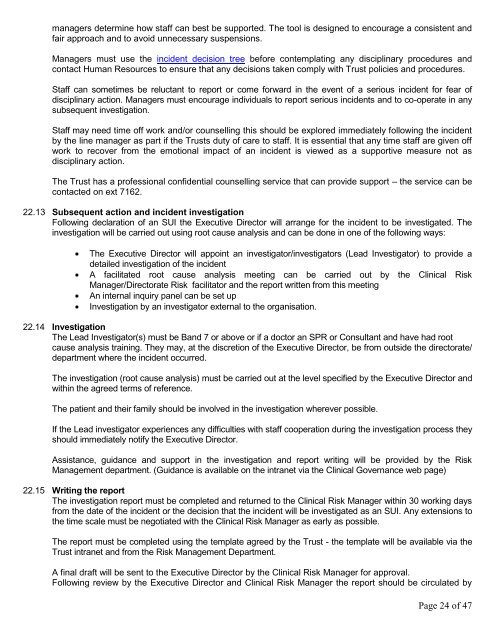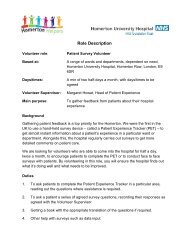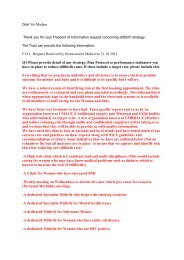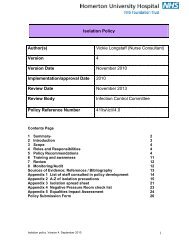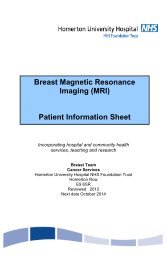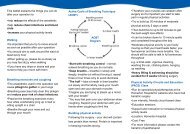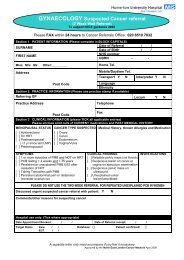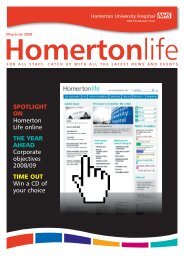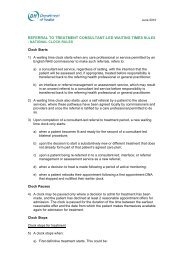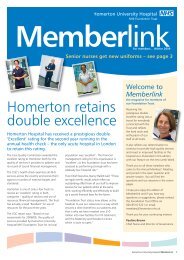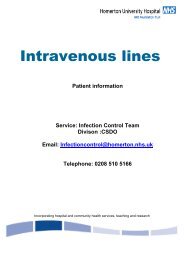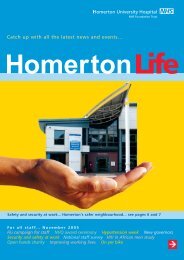Incident reporting policy - Homerton University Hospital
Incident reporting policy - Homerton University Hospital
Incident reporting policy - Homerton University Hospital
You also want an ePaper? Increase the reach of your titles
YUMPU automatically turns print PDFs into web optimized ePapers that Google loves.
managers determine how staff can best be supported. The tool is designed to encourage a consistent andfair approach and to avoid unnecessary suspensions.Managers must use the incident decision tree before contemplating any disciplinary procedures andcontact Human Resources to ensure that any decisions taken comply with Trust policies and procedures.Staff can sometimes be reluctant to report or come forward in the event of a serious incident for fear ofdisciplinary action. Managers must encourage individuals to report serious incidents and to co-operate in anysubsequent investigation.Staff may need time off work and/or counselling this should be explored immediately following the incidentby the line manager as part if the Trusts duty of care to staff. It is essential that any time staff are given offwork to recover from the emotional impact of an incident is viewed as a supportive measure not asdisciplinary action.The Trust has a professional confidential counselling service that can provide support – the service can becontacted on ext 7162.22.13 Subsequent action and incident investigationFollowing declaration of an SUI the Executive Director will arrange for the incident to be investigated. Theinvestigation will be carried out using root cause analysis and can be done in one of the following ways:The Executive Director will appoint an investigator/investigators (Lead Investigator) to provide adetailed investigation of the incidentA facilitated root cause analysis meeting can be carried out by the Clinical RiskManager/Directorate Risk facilitator and the report written from this meetingAn internal inquiry panel can be set upInvestigation by an investigator external to the organisation.22.14 InvestigationThe Lead Investigator(s) must be Band 7 or above or if a doctor an SPR or Consultant and have had rootcause analysis training. They may, at the discretion of the Executive Director, be from outside the directorate/department where the incident occurred.The investigation (root cause analysis) must be carried out at the level specified by the Executive Director andwithin the agreed terms of reference.The patient and their family should be involved in the investigation wherever possible.If the Lead investigator experiences any difficulties with staff cooperation during the investigation process theyshould immediately notify the Executive Director.Assistance, guidance and support in the investigation and report writing will be provided by the RiskManagement department. (Guidance is available on the intranet via the Clinical Governance web page)22.15 Writing the reportThe investigation report must be completed and returned to the Clinical Risk Manager within 30 working daysfrom the date of the incident or the decision that the incident will be investigated as an SUI. Any extensions tothe time scale must be negotiated with the Clinical Risk Manager as early as possible.The report must be completed using the template agreed by the Trust - the template will be available via theTrust intranet and from the Risk Management Department.A final draft will be sent to the Executive Director by the Clinical Risk Manager for approval.Following review by the Executive Director and Clinical Risk Manager the report should be circulated byPage 24 of 47


